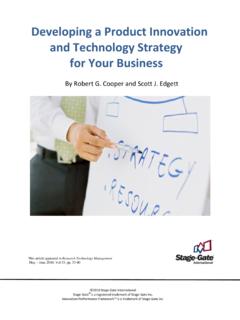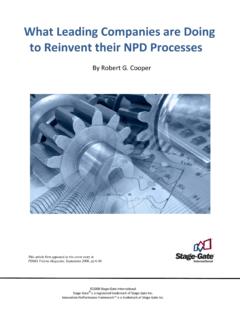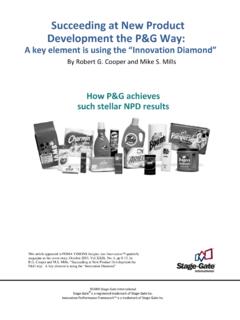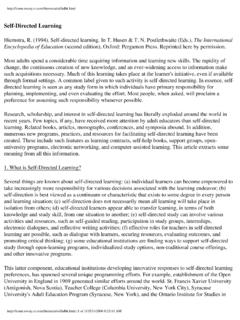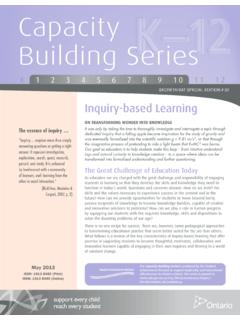Transcription of Best Practices in the to Process and Its Governance
1 Best Practices in the Idea to Launch Process and Its Governance By Robert G. Cooper and Scott J. Edgett This article appeared in research Technology Management March April 2012, pp. 43-54 2012 Stage Gate International Stage Gate is a registered trademark of Stage Gate Inc. Innovation Performance Framework is a trademark of Stage Gate Inc. research -Technology Management March April 2012 | 43 Numerous studies have probed why some new products are great successes while others fail commercially. These investi-gations have identifi ed a myriad of success drivers, including developing a differentiated product with a compelling value proposition; building in the voice-of-the-customer input; un-dertaking the front-end homework; seeking sharp, early product defi nition; providing adequate resourcing; and rely-ing on an effective cross-functional development team.
2 (For a review of these studies, see Cooper, in press ). A number of organizations have built these success drivers into their de-velopment methodologies in the form of a structured idea-to-launch Process or system, such as Stage-Gate ( Koen 2003 ; Gr lund, R nneberg, and Frishammar 2010 ; Adams and Hubilkar 2010 ; DOE 2007 ; Cooper 2011 ). 1 Similarly, other studies have probed why some businesses are so successful at new-product development, while others are not (see, for instance, Cooper, Edgett, and Kleinschmidt 2003 , 2004a , 2004b , 2005 ; Adams 2004 ; Jaruzelski, Dehoff, and Bordia 2005 ). Many success factors have been uncov-ered in these benchmarking studies, including having a prod-uct innovation and technology strategy to guide development efforts, fostering the right climate and culture for innovation, implementing effective ideation Practices , putting the neces-sary resources in place and investing in the right projects (portfolio management), and having an effi cient idea-to-launch system ( Jaruzelski, Dehoff, and Bordia 2005 ; Cooper and Mills 2005 ; Cooper, in press ).
3 A recurring best-practice theme is the use of some form of gating Process . For example, a global study of 1,000 fi rms revealed that it s the Process , not the pocketbook. Superior results seem to be a function of the quality of an organiza-tion s innovation Process the bets it makes and how it pur-sues them rather than the magnitude of its innovation Robert G. Cooper is president of the Product Development Institute. He is a professor emeritus in McMaster University s DeGroote School of Business, ISBM Distinguished research Fellow at Penn State University s Smeal Col-lege of Business Administration, and a Crawford Fellow of the Product De-velopment and Management Association. A thought leader in the fi eld of product innovation management and developer of the Stage-Gate new-product development Process , he has won two IRI Maurice Holland awards and has published over 120 articles and ten books.
4 He received his PhD in business administration from the University of Western Ontario and Bache-lors and Masters degrees in chemical engineering from McGill University. Scott J. Edgett is CEO and co-founder of the Product Development Insti-tute and Stage-Gate, International. He is also a faculty scholar with ISBM at Penn State University s Smeal College of Business Administration. A special-ist in new-product development and portfolio management, he received his PhD in marketing from Bradford University. He has consulted and written extensively in the fi eld, with over 60 published articles and seven books. His latest book (co-authored with Robert Cooper) is Product Innovation and Technology Strategy (BookSurge, 2009). DOI: Best Practices in the Idea-to-Launch Process and Its Governance A study of new-product development Practices at 211 businesses provides insights into best Practices in both the idea-to-launch Process and its Governance .
5 Robert G. Cooper and Scott J. Edgett OVERVIEW: Most fi rms now use some form of idea-to-launch Process such as a Stage-Gate system. The question is: Do these processes really work? And what are the elements of a best-in-class idea-to-launch system that really make a differ-ence? A second and related question concerns the Governance of the idea-to-launch model. Sadly there is a lack of hard evi-dence as to what Governance structure works best and just what its impact is, if any. This article reports the results of an American Productivity & Quality Center (APQC) and Product Development Institute (PDI) study of 211 businesses with a focus on performance metrics and Practices . Top performing businesses are identifi ed, and those Practices that distinguish these businesses from the rest are probed. The article provides insights into best Practices in both the idea-to-launch Process and its Governance that are strongly connected to positive innovation performance.
6 KEYWORDS: Idea-to-launch Process , New-product development , Metrics , Stage-Gate 1 Stage-Gate is a registered trademark of the Product Development Institute Inc. | research -Technology Management Best Practices in Idea-to-Launch spending ( Jaruzelski, Dehoff, and Bordia 2005 , 11). Another more recent and large-scale study notes that effective inno-vators tightly manage the innovation Process . As they execute the four principal elements of innovation ideation, project selection, product development, and commercialization every company Booz Allen Hamilton talked to had a disci-plined Stage-Gate Process combined with regular measurement of everything from time and money spent in product de-velopment to the success of new products in the market ( Booz Allen Hamilton 2007 ). Other studies also note the wide reliance on some form of idea-to-launch Process such as a Stage-Gate system ( Griffi n 1997 ; APQC 2002 ; Cooper, Edgett, and Kleinschmidt 2003 , 2005 ; Koen 2003 ; Adams 2004 ; Mills 2007 ; Gr lund, R nneberg, and Frishammar 2010 ).
7 The question is, do these processes really work? And what elements of a best-in-class idea-to-launch system really make a difference? For example, there is some debate about the optimal level of fl exibility in such a system, or whether there should be different versions of the Process to accommodate different types of development projects versus a one-size-fi ts-all model. A second and related question concerns the gover-nance of the idea-to-launch model. A study by Nielsen revealed that for consumer products, a system consisting of rigorous gates, scorecards and a Governance body works much better than looser gates with heavy executive involve-ment, achieving a remarkable six times the performance in terms of annual sales from new products ( Agan 2010 ). Ad-ditional anecdotal evidence also suggests that the Governance system is critical.
8 Sadly there is a lack of hard evidence to sug-gest what Governance structure works best and just what the impact of Governance is, if any. The Study In 2011, the American Productivity & Quality Center (APQC) and the Product Development Institute (PDI) undertook a study to explore these questions, among others. 2 The pur-pose of the study was to identify best Practices as they pertain to the idea-to-launch model; in particular, the research sought to answer two key questions: 1. Do Stage-Gate processes really work, and what facets of these systems really make a difference? 2. What type of Governance structure works best for such processes? Via a two-step data collection Process that included both de-tailed questionnaires and in-depth site visits (see How the Study Was Done, above), the study sought information about the idea-to-launch Practices of 211 best-performing business units in a range of industries ( Table 1 ).
9 Business units in the study population have median sales of $1 billion and a median workforce of 2,500 employees. Median R&D spending for participating businesses is percent of sales. Identifying Best Performers Identifying best and worst performers is the basis of a valid benchmarking study. Comparing the Practices used by best versus worst performers allows researchers to zero in on drivers of performance and identify best Practices . There are many metrics that measure a business s performance at new-product development, and some of these were considered in this study, including popular but problematic ones. TABLE 1 . Industry representation of participating businesses. Industry/Sector% of Respondent Businesses Consumer Healthcare products, supplies, Industrial, equipment, mechanical (B2B) Chemical, including Telecommunications Other How the Study Was Done In the fi rst part of the study, researchers distributed a de-tailed, lengthy quantitative questionnaire asking about companies idea-to-launch processes to AQPC member companies indicating an interest in product innovation and to the PDI membership mailing list.
10 In total, 257 compa-nies responded to the e-mail solicitation. Refi nement of the data sample plus the removal of small organizations led to a useable sample of 211 respondents. Question-naire respondents included a mix of people ranging from executives to Process managers. Best-performing businesses were identifi ed from an analysis of three performance metrics, namely overall new-product productivity, the degree to which new products met the business s profi t objectives, and the degree to which new products met sales objectives. The Practices as-sociated with these best-performing businesses were iden-tifi ed as best Practices and their impact on performance quantifi ed. The second part of the study involved in-depth site vis-its at a select set of businesses identifi ed as having superb Practices .
